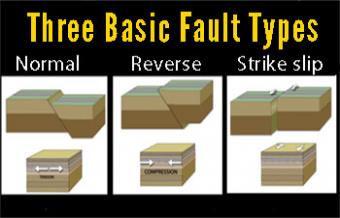________ Is Used to Describe Movement on Faults
A normal fault may therefore become a reverse fault and vice versa. The term ________ is used to describe the geopolitical processes of small scale independence movements based upon ethnic fault lines.

Fault Types 3 Basic Responses To Stress Incorporated Research Institutions For Seismology
What type of fault is the San Andreas Fault.

. P waves S waves Love waves and. Explain how plate movements resulted in the formation of folds faults trenches volcanoes rift valleys and mountain ranges. Tectonic plates are slabs of crusts in which its movement form faults.
Effect of the movements of the plates to both the biotic and abiotic components of the Earth. A _____ fault has little or no vertical movements of the two blocks. Faults may be reactivated at a later time with the movement in the opposite direction to the original movement fault inversion.
When the hanging wall moves upward relative to the footwall then compressional stress is formed between the fault blocks. Recall this information gives an idea of what sort of fault was involved. QUESTION 39 What term two words do seismologists use to describe the initial movement or a reaction of a seismometer to an earthquake.
In a _____ fault the hanging wall block move up with respect to the footwall block. Faults slow creep between large earthquakes are commonplace. Faults may range in length from a few millimeters to thousands of kilometers.
In each photo the red line indicates the location of the Hayward fault and the red arrows indicate the direc-tion of fault movement by this right-lateral strike-slip. When the hanging wall moves upward relative to the footwall then compressional stress is formed between the fault blocks. Fault is the general term used to describe break in rock layers.
Also an intuitive approach can be used but must be accompanied by a deductive technique. Fault is the general term used to describe break in rock layers. Synthetic and antithetic faults are terms used to describe minor faults associated with a major fault.
Describing motion that is a combination of movement both perpendicular and parallel to the strike of a fault -- a combination of strike-slip and dip-slip whether normal or reverse. Diagnosis of faults requires a logical and disciplined approach. This term is used to describe both sudden slip on a fault and the resulting ground shaking and radiated seismic energy caused by the slip or by volcanic or magmatic activity or other sudden stress changes in the earth.
Are horsts and grabens bounded by normal or reverse faults. On the basis of the apparent movement of blocks fault have the following types. This movement may occur rapidly in the form of an earthquake - or may occur slowly in the form of creep.
NORMAL DIP SLIP FAULT Dip Slip refers to the movement of faults along the angle of the fault plane. Earthquake Hazard Anything associated with an earthquake that may affect the normal activities of people. TRUE OR FALSE 1.
Of the former Yugoslav republics only ___________has actually achieved membership in the EU although all Balkan countries have begun the lengthy and complex EU membership process. Seismologist call this These two words must be in the correct order to you to get full credit and your answer must be right on the money. When they encountered a coal seam disrupted by a.
Kinesthetic imagery is imagery that describes movement. Normal fault is one in which the hanging wall falls down relative to the foot wall due to tensional stress it is also called gravity faultapparent. A fault is a fracture or zone of fractures between two blocks of rock.
Tectonic plates are slabs of crusts in which its movement form faults. Name four instruments that are used to detect movement along faults. Faults allow the blocks to move relative to each other.
Faults can be classified as. Positive fault sustained fault Intermittent fault irregular harder to find Tools for the Job. From first to last in what order are seismic waves registered on a seismograph.
Does the hanging wall block move up or down along a reverse fault. These structures include top a now-abandoned school and bottom a stone wall in a park in the city of Hayward. Answered TRUE OR FALSE 1.
2 Classification of faults on the basis of apparent movement of blocks. Frequently past experience or detailed knowledge will help. View an animation of oblique slip 89 K.
What term is used to describe an area where pressure is accumulating but the fault is locked. Which is an example of a fault with horizontal movement. Science 11112020 1155 villatura.
It also comes from the root word kinesis which means movement. What is the word for an array of. Faults in which movement is mainly horizontal and parallel to the trend of the.
Synthetic faults dip in the same. English coal miners used the terms to describe the way a line of coal was disrupted by the movement of a fault. The four instruments that are used to detect movement along faults are Tiltmeter Creep Meter Laser-Ranging device and GPS.
Describe the patterns of the movements of the plates. Where the crust is being pulled apart normal dip slip occurs in which the overlying hanging wall block moves down with respect to the lower footwall block. After going through this module you are expected to.
Faults only occur along plate boundaries. The word _____ is used to describe movement on faults.

Different Types Of Faults Teaching Science Subduction Geology

Do You Know The Different Types Of Faults Geology Plate Tectonics Transform Boundary

No comments for "________ Is Used to Describe Movement on Faults"
Post a Comment